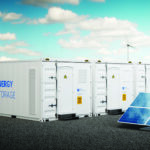A new report from a global research, data, and analytics firm says the total market for energy storage will reach $546 billion in annual revenue over the next 15 years, led by the continued electrification of the transportation sector.
Lux Research, a Boston, Massachusetts-headquartered group, in its “Global Energy Storage Market 2019” report, estimates the leading drivers of energy storage—mobility, stationary storage, and electronic devices—will reach an annual combined deployment level of 3,046 GWh by 2035, up from the current 164 GWh.
“The energy storage industry is poised for a massive increase in annual revenue and deployment capacity as key innovative technologies, such as solid-state batteries and flow batteries, reach commercialization,” said analyst Chloe Holzinger, a lead author of the report. “We continue to expect electric mobility applications, primarily light-duty passenger vehicles, to be the principal long-term driver of energy storage annual revenue and demand, with a total market share of 74% by annual revenue and 91% by annual deployed GWh by the year 2035.”
Energy storage in the power generation sector is being driven largely by battery energy storage systems (BESS), often used in conjunction with solar and wind farms to store power for use when the sun isn’t shining or the wind isn’t blowing. BESS installations also are being used to respond to demand spikes on the power grid.
Transportation Leads Market
Lux, in a news release about its report, said, “Growth in revenue and deployment for the energy storage market over the next three years will be markedly different from the overall 2035 projections, with plug-in light-duty vehicles remaining the largest market with a predicted $24 billion increase in revenue by the end of 2022. Medium- and heavy-duty vehicles come in next, growing from $600 million a year in 2019 to a projected $3.6 billion per year in 2022, but have the highest combined annual growth rate (CAGR) of 80%.” Residential storage has a CAGR of 76% and $8 billion revenue increase over the next three years, followed by personal mobility with a CAGR of 49% and $4.6 billion revenue increase.
The report said the stationary storage market, which aligns with power generation, will surpass the electronic devices market in 2023, “when we project it will become a $30 billion industry of 52 GWh in installations. This growth will be driven by the commercialization of several key innovative technologies, including solid-state batteries and flow batteries.” The report said the stationary storage market will be a $111.8 billion sector in 2035, up from $9.1 billion today.
“The increased value proposition of energy storage in electricity markets will more than make up for a slowdown in cost reductions,” according to the report. “Wind and solar will grow to a third of worldwide generating capacity, building opportunities for stationary storage to balance the growth of non-dispatchable renewables. Electricity market reform will enable stationary storage to participate more broadly in more regions: By 2035, more than 40% of annual deployments will take place in evolving grids like China, India, Southeast Asia, and Africa.”
The report identifies five major technologies that are well-positioned to drive growth in energy storage markets: battery recycling, electric aviation, flow batteries, thin-film batteries, and solid-state battery improvements. The report notes efforts “to develop ultra-long-duration storage,” while also discussing the need “to link excess renewable generation to other industries like chemicals or transportation through hydrogen generation. Long-duration storage versus sector coupling will be the next great debate in the power sector, the outcome of which will shape industry and mobility for decades.”
Utility Programs Will Drive Adoption
Rami Reshef, CEO of GenCell, a fuel cell company, recently talked about energy storage with POWER, saying, “Meeting ambitious clean energy objectives to reduce carbon emissions and to improve energy efficiency mandates that utilities radically revise their standard energy generation practices.” He continued: “To ensure stable power, the utility must balance intermittent sources with complementary storage and generation solutions that provide backup energy when the intermittent sources are not available. Utilities are today investing in diverse technologies to achieve this balance.”
As an example, Hawaiian Electric, a Honolulu-based utility, has launched innovative solar-plus-storage contracts, matching all new solar capacity that it procures with an equal capacity of four-hour-duration storage. The utility does not purchase the power produced by each solar-plus-storage installation, but instead makes a fixed monthly payment to the plant owner, with the utility controlling the dispatch of the solar-plus-storage plant.
Said Reshef: “Hybrid solutions incorporating fuel cells, batteries and other ESS [energy storage] systems ensure continuous power supply and response to peak demands. Cities and states need to stay on top of these dynamic changes to ensure that the public systems meet the power needs of all stakeholders in the network and to ensure that auxiliary power systems are in place to protect all consumers.”
—Darrell Proctor is a POWER associate editor (@DarrellProctor1, @POWERmagazine).










